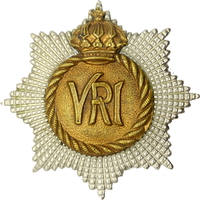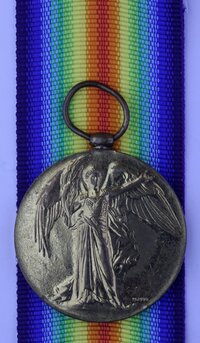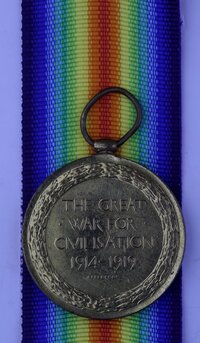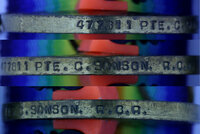
477811 Private George Sanson
The Royal Canadian Regiment
By: Capt (ret'd) Michael M. O'Leary, CD, The RCR
George Sanson was born in Brentford, Middlesex, England, on 21 May 1886.
On 30 Jul 1914, Sanson joined the Canadian Permanent Force when he enlisted with The Royal Canadian Regiment at Halifax, N.S. He was posted to "D" Company and given the regimental number 9815. An ex-British Army soldier, Sanson's entry in the regimental Quarterly Pay Record ending 30 Sep 1914 includes the following annotation; "Refund $5.00 per month, and $10.00 transportation to Immigration League." The next entry, for 9816 Pte. A.H. Perkins, who enlisted the same date and was a British Army Reservist, has a similar note.
The Naval and Military Emigration League (NMEL), founded in November 1909, was a British emigration society engaged with the British and Canadian Governments as they supported the emigration of British ex-servicemen. In cases where the ex-serviceman did not have means to pay for transportation, the League advanced funds. The League supported initiatives to assist ex-British servicemen to emigrate to Canada into available employment with emphasis on farming. Their efforts also included the recruiting of British Army reservists for the Canadian Permanent Force. At times, those who accepted the League's assistance were released from their Army Reserve obligations on enlisting in Canada. But, as political tensions increased in Europe, those obligations remained in place and Canada accepted liability that those soldiers may have to be transferred back to their original regiments.
Within two months of his enlistment, on 11 Sep 1914, Sanson and The RCR sailed for Bermuda where the Regiment relieved the 2nd Battalion, Lincolnshire Regiment, which sailed immediately for England. For the following year, The RCR would serve as the garrison battalion on the island.
Having reached Bermuda as a battalion of ten companies, and adding four more provisional companies of reinforcements from Camp Valcartier to reach war establishment numbers, The RCR was reorganized in October, 1914. As part of this reorganization, the soldiers of the original "B" and "D" Companies were reconstituted as the new "B" Company in an eight-company battalion. The Regiment would reorganize again before sailing for Europe in a four-company organization. Sanson, who had begun his regimental service in "D" Company was transferred to the new "B" Company.
In the paylist for October 1914, Sanson and Perkins are shown on a list for Working and Extra Duty Pay and Allowances as receiving a monthly allowance of £ 2 1s 1d (about $10.00) under "Transport for Recruits." This shows that their commitment to reimburse the Immigration League was still being honoured by the Canadian military.
On 12 Aug 1915, The RCR was relieved of its duties in Bermuda by the arrival of the 38th Overseas Battalion from Canada. The RCR returned to Halifax for a stay of only a week. During this time, the Regiment was re-attested for overseas service. Although The RCR had just spent a year in Bermuda, there were concerns regarding the applicability of the soldiers' Permanent Force enlistments for wartime deployments. This was, perhaps, prompted by the idea that a man on a P.F. three-year engagement could choose not to re-engage and the Government would be obligated to bring him home. Enlistment in the C.E.F., on the other hand, was for the "Duration of War." Accordingly, the soldiers of The RCR were re-attested, signing C.E.F. attestation papers in August 1915 before sailing for Europe.
Sanson attested for service in the Canadian Expeditionary Force (C.E.F.) with The RCR at Halifax, N.S., on 23 Aug 1915. A 29-year-old labourer, Sanson was described on his attestation paper as 5 feet 8 inches tall, with a 38-inch chest, a fresh complexion, brown eyes, and brown hair. His religious denomination was Church of England. Sanson identified his father, George Sanson, 54 Calling Rd., Brentford, Middlesex, Eng., as his next of kin.
On his attestation form, Sanson noted prior service in the British Army of 7 years, 325 days, with the Loyal North Lancashire Regiment. Under distinguishing marks, his service records notes a tattoo on his left forearm of the "letters I.L.N.L." although this is possible a misinterpretation of "1 L.N.L. denoting his battalion in that regiment. The 1st Battalion, L.N.L. Regiment, served in England and Ireland in the decade before the First World War,
On 26 Aug 1915, The RCR sailed from Halifax aboard the S.S. Caledonian, the same ship that had brought them home from Bermuda. Disembarked at Plymouth, England, on 6 Sep 1915, the Regiment went to Shorncliffe for training.
Sanson received a new C.E.F. service number on 28 Sep 1915 to replace the regimental number he received on enlisting. While serving in the C.E.F., his service number was 477811. Since the Regiment received its C.E.F. numbers while at full strength and not as they were recruited, it had the interesting effect that the soldiers of the Regiment at the time were renumbered in alphabetical order.
The RCR crossed the English Channel on 1 Nov 1915, entering the theatre of war at Boulogne, France. During November and December of 1915 the Regiment prepared for service in the trenches, with companies rotating in the lines for training and a period of providing working parties before entering the line as a battalion at the end of December. The first months of 1916 saw the Regiment in the steady rotation through front line trenches, support trenches, and reserve positions that was the fundamental experience of the infantry in the Great War.
Commencing 1 Dec, 1915, Sanson established a monthly Pay Assignment of $20 to be sent to Miss M. Tassell, 261 High St., Brentford, London, W. As a Private in the C.E.F., Sanson was paid $1.00 per day plus an additional ten cents daily field allowance. His pay assignment represented about two-thirds of his monthly pay. In May, 1918, Sanson reduced the amount of assigned pay to $15 and changed the recipient to his father.
On 1 Mar 1917, Sanson was attached to the 3rd Canadian Division Headquarters as Batman to Capt J.W. Coupe. John William Coupe was a long-serving Royal Canadian who had enlisted with the Regiment on 14 Dec 1892. A veteran of the Yukon Field Force (1898-1900), he had risen to the appointment of Sergeant-Major (Orderly Room Clerk) by April, 1914. Coupe was appointed Quartermaster with the Honorary rank of Lieutenant on 17 Nov 1914 while the Regiment was in Bermuda. Coupe served as the Regiment's Quartermaster and later as Paymaster before he left the Regiment for staff appointments.
Sanson's employment as Coupe's batman, i.e., soldier-servant, was under the authority of the King's Regulations and Orders. Details for the employment of officers' servants are detailed in both the KR&O for the Canadian Militia dated 1910 and in KR&O for the Army 1912. It was under the latter that the Regiment served outside of Canada. Relevant passages from the section titled "Soldier-Servants and Orderlies" read as follows:
"Para 1347. The employment of soldiers (when available) as officers servants and grooms is sanctioned, as an indulgence. They will, in all cases, rejoin their units when the latter, if abroad, are ordered to quit the command, or, it at home, to move out of the United Kingdom.
"Para 1348. soldier-servants will be selected from those who have done duty in the ranks of dismounted corps for one year, or of mounted corps for eighteen months. They will be completely clothed, armed, and equipped; they will mount and perform their share of duty on any guard, or other service, on which the officer to whom they are attached is employed; and when not required to take charge of spare horses, they will be in the ranks at all reviews, inspections and field days. They will go through the annual course of musketry, and are liable to such training as the C.O. may judge necessary.
"Para 1351. An officer employed on staff duty in the field, in an acting staff appointments, as superintendent of gymnasia, under instruction at the gymnasium, Aldershot, or on any temporary military duty away from his unit, may retain his soldier-servant.
"Para 1355. The payment by officers to soldiers employed as their servants is … in the infantry 1s. 6d. per week [about $1.25] to personal servants …"
While their records do not indicate exactly when Sanson began his duties as Coupe's batman, their movements after leaving The RCR are matched in their service records. After seven months at 3rd Can. Div. HQ, Sanson returned to The RCR for one month on 28 Sep 1917. He was struck off strength a month after that, on 29 Oct 1917, and transferred to the Headquarters of the 5th Can. Inf. Brigade to rejoin Coupe in a new appointment.
Sanson did not return to The RCR until 2 Nov 1918 when he was struck off the strength of the 5th C.I.B. HQ. He ended the year 1918 on leave. He was granted 14 days leave in the United Kingdom commencing 23 Dec 1918.
On 3 Mar 1919, Sanson was struck off strength of The RCR on being posted to Nova Scotia Regimental Depot (N.S.R.D.) at Ripon. The N.S.R.D. was a unit of the regionally based reinforcement system created in early 1917, with named Depots taking in troops from battalions raised in those areas in Canada and providing reinforcement drafts to similarly designated fighting units. The RCR, having been headquartered in Halifax in the decade before the War, was associated with the N.S.R.D. These Depots also became the parent unit for any soldiers returned to England from their affiliated battalions in France and Flanders.
Sanson did not return to Canada with The RCR. On 9 May 1919, he ceased to be shown on furlough and was shown On Command to No. 2 Canadian Discharge Depot, London, pending discharge in England. The following day, 10 May 1919, Sanson was discharged in the British Isles in accordance with K.R.&O. para 392, Sec xxv.
On discharge, Sanson was eligible to receive a War Service Gratuity of £ 86-6-0. Cheques were issued to him in six installments between May and October 1919.
In September, 1920, Sanson sent a pre-formatted post card to the Secretary of the Militia Council to update his address for the forwarding his medals once they were available. The address he provided was No. 9 Netley Rd., Brentford, Middlesex, Eng. His medal card reveals a further change of the street address to No. 8 Cressage Rd.
For his service in the C.E.F., Sanson was entitled to receive the 1914-15 Star, the British War Medal, and the Victory Medal. These were despatched to him at Brentford in June and August, 1921.
Sanson's life after the war, like his years before 1914, have left very little evidence in available records. His name does appear twice in regimental journals, once in 1956 and again in 1963.
In the Fall 1956 edition of The Connecting File, the regimental journal of The RCR, there is a report provided by the Toronto Branch of The RCR Association. Describing the Branch's Paardeberg Dinner held on 27 Feb 1956, one of the attendees is George Sanson. The article mentioned him in the list of attendees and in this remark: "The evening closed with entertainment by Stephen Hughes (Vice President) and George Sanson with his guitar. Ex-Cpl Ralph Boddington gave us jive, rumbas and also the shivers."
Sanson is named in The Connecting File, Vol. XXXIV, No. 1, 1963, in the article provided by the United Kingdom Branch of the Association: "We would appreciate any information on the following old comrades who are known to be resident in the UK.: A. Leeson, A.R. Hines, H. Burton, G. Mannion, H.A. Fraser, E. Turner, George Sanson, Fred Dodson, Pete Boudreau, Tommy Colbourne."
Batman to Capt J.W. Coupe.
Batman to Capt J.W. Coupe.' },
![]()
![]() 477811 Private George Sanson
477811 Private George Sanson
Batman to Capt J.W. Coupe.
![]()
![]() 477811 Private George Sanson
477811 Private George Sanson
Batman to Capt J.W. Coupe.
Pro Patria
Visit a randomly selected page in The O'Leary Collection (or reload for another choice):
- The O'Leary Collection; Medals of The Royal Canadian Regiment.
- Researching Canadian Soldiers of the First World War
- Researching The Royal Canadian Regiment
- The RCR in the First World War
- Badges of The RCR
- The Senior Subaltern
- The Minute Book (blog)
- Rogue Papers
- Tactical Primers
- The Regimental Library
- Battle Honours
- Perpetuation of the CEF
- A Miscellany
- Quotes
- The Frontenac Times
- Site Map
QUICK LINKS
The O'Leary Collection—Medals of The Royal Canadian Regiment
Newest additions:
![]()
![]() SB-12725 Private Henry "Hank" Ard
SB-12725 Private Henry "Hank" Ard ![]()
WIA at Hill 187, Died of Wounds in Japan
![]()
![]() 2355331 Lance Corporal Albert Lorking
2355331 Lance Corporal Albert Lorking
Wounded in action, later a War Amps representative.
![]()
![]() 4334 / 477996 Pte Isaac Hamilton Wilcox
4334 / 477996 Pte Isaac Hamilton Wilcox
Permanent Force, South Africa, and C.E.F.
![]()
![]() 477019 Private Harold Ashcroft
477019 Private Harold Ashcroft
Transferred to the Tunnelers.
![]()
![]() 734231 Private Clark D. Thompson
734231 Private Clark D. Thompson ![]()
The older Thompson brother, killed in action.
![]()
![]() 733849 Private Norman Parker Thompson
733849 Private Norman Parker Thompson
The younger Thompson brother; post-war service in the Special Guard.
![]()
![]()
![]() A305 / 400305 Private Andrew Walker
A305 / 400305 Private Andrew Walker ![]()
"Previously reported Wounded, now Killed in Action."
![]()
![]() 823298 Pte Thomas Patrick Steele, M.M.
823298 Pte Thomas Patrick Steele, M.M. ![]()
… for gallant conduct in the field …
![]()
![]() P13066 Sergeant Harold Thompson
P13066 Sergeant Harold Thompson
Instrumental Soloist for over 20 years of Canadian Army service.
![]()
![]() 9609 / 477728 Private Albert Edward Piper
9609 / 477728 Private Albert Edward Piper
"Arrived from England as a STOWAWAY …"





